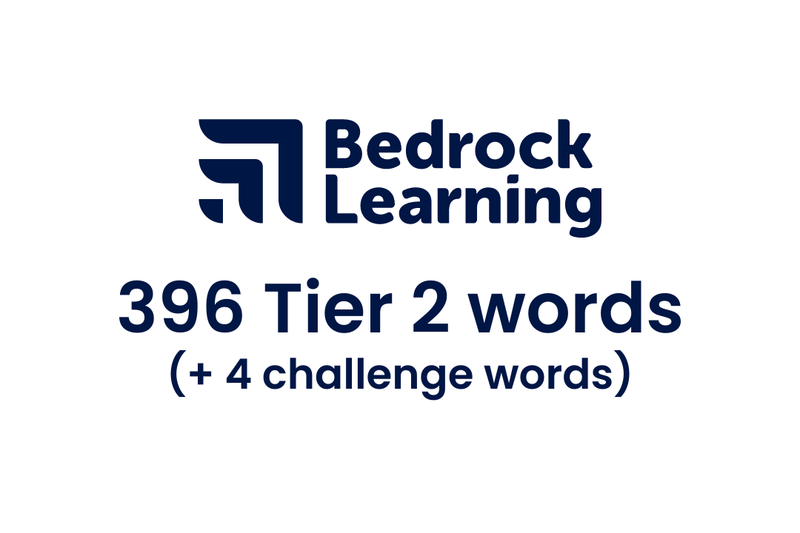What is Tier 2 vocabulary?
Having a rich, ambitious, broad vocabulary is vital for learners to succeed, both in school and throughout their lives - but not all vocabulary is made the same or has the same purpose. In order for teachers to best tackle the broad subject of “vocabulary”, there has to be a way to break it down into smaller chunks so that each can be taught more efficiently. This is where the three tiers of vocabulary become important.
Beck, McKeown and Kucan (2002) came up with an efficient way of breaking down vocabulary, and vocabulary instruction, into smaller, more manageable parts. In their book Bringing Words to Life, they segmented the vocabulary we use into three tiers - Tier 1, Tier 2 and Tier 3.
Tier 1 vocabulary is the simplest. These are the words we use in everyday conversation, such as “put”, “get”, “walk”, etc. Tier 1 language is used in casual conversation everyday, and doesn't usually require explicit teaching for learners to understand them. Knowing Tier 1 vocabulary gives learners the basic language skills they need to communicate with others, but this vocabulary is not enough for them to achieve their full potential.
On the other side of the spectrum, Tier 3 vocabulary is the subject-specific vocabulary of a particular discipline. These are words that aren’t used outside of the context of a specific subject, or have a different meaning in one subject versus another. For example, “tectonic” is a word that you wouldn’t usually use outside of Geography, and “refraction” is a word commonly found in the Physics classroom.
Read more about Tier 3 vocabulary.
In the middle of these two tiers is Tier 2 vocabulary. Tier 2 vocabulary, while not as specific as Tier 3, are challenging, ambitious words that don’t usually crop up in day-to-day conversation. These are the words that allow us to access academic texts, such as high-level literature, newspaper articles and exam papers. While these words aren’t used that often in casual dialogue, they are essential to unlocking learners’ potential in academia - for this reason, they often need explicit teaching in the classroom.
In order to access the world around them, learners need a rich understanding of all three tiers of vocabulary - this enables them to change their formality of speech depending on their audience, access the complex language of literature and exam papers, and think like experts in specific disciplines. Tier 2 vocabulary is just one part of enriching learners with the literacy skills they need to thrive - but it is a vital part all the same. That’s why we have collated a list of 396 Tier 2 words learners should know to reach their full potential in school.
Why is Tier 2 vocabulary important?
The reading age of the average GCSE exam paper is 16 years and 3 months. This means that complex, Tier 2 language is embedded within the questions. However, one in three UK students don’t have the Tier 2 vocabulary required to access the language of their exam papers. This sets them back in every subject - how is a learner meant to demonstrate their knowledge of Maths or Science if they don’t have the language to understand the question?
Beyond the classroom, also, a rich knowledge of Tier 2 vocabulary allows learners to experience the world around them. A wide vocabulary gives learners the confidence to enjoy reading, a habit that has life-long benefits. As well as this, important life events such as job interviews, constructing a CV, writing an essay, even watching the news requires Tier 2 vocabulary. When we explicitly teach learners the ambitious language they need, we allow them to learn through literacy, for life.
Explicit vocabulary instruction becomes even more important when we consider the ways learners encounter Tier 2 vocabulary. Psychologists and educational experts identified that by as young as the age of four, children from wealthier backgrounds have encountered significantly more ambitious vocabulary than children from less affluent backgrounds. Many studies disagree on how large this “word gap” is, with one study calculating it at 30 million words, but it’s undeniable that a language gap forms between children of different backgrounds even in their earliest years. Without intervention, this language gap continues throughout learners’ academic careers, affecting their exam results and their opportunities in the wider world.
Vocabulary acquisition becomes an increasingly complex issue when we consider the changing make-up of learners in the United Kingdom. Today, around 1 in 5 students are learning English as an additional language (EAL). Research by David Didau has shown that after the age of five, we encounter most of our new vocabulary through reading - but this only works if learners are reading at all. Without the fundamental building blocks of reading, such as a wide knowledge of Tier 2 vocabulary, learners are prevented from independently broadening their vocabularies - and this can have even more detrimental effects on EAL students.
If teachers leave acquiring ambitious vocabulary up to chance, this gap will never close, leaving less affluent children at a disadvantage throughout their education. Explicit Tier 2 vocabulary instruction levels the playing field, giving learners of all backgrounds the opportunity to flourish.
Broaden your learner's vocabulary with Bedrock
With Bedrock's extensive vocabulary curriculum, you are no longer leaving language acquisition to chance. Trial our app free today.
Tier 2 word list
In our full word list, we have compiled 396 Tier 2 words (plus 4 extra challenging words) you can use to enrich your vocabulary lessons. Some of these words are informed by Marzano’s academic vocabulary list - this list provides a concise list of the most important academic words learners need to succeed in school.
However, other words are selected for the purpose of creativity and description. Not only should we be aiming to prepare learners for the exam hall, but also cultivate a love of reading and writing. What better way to do that than equip learners with exciting vocabulary to describe the world around them (or even to describe new worlds)?
Below, we highlight one Tier 2 word from each letter of the alphabet, giving you a great starting point for your Tier 2 vocabulary journey.
A - Advocate
B - Benefit
C - Clarity
D - Define
E - Eccentric
F - Fantasy
G - Grapple
H - Hierarchy
I - Illusion
J - Justify
K - Keen
L - Liberate
M - Modify
N - Notation
O - Objective
P - Pigment
Q - Qualify
R - Reversible
S - Stealthily
T - Triumph
U - Underestimate
V - Victory
W - Welfare
X & Y - Okay, we really struggled with these ones. Maybe you could share some ideas with us on our Twitter?
Z - Zealous
To find even more Tier 2 vocabulary that you can use to inform your vocabulary lessons, download our full Tier 2 word list.


